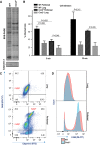Downregulation of calponin 2 contributes to the quiescence of lung macrophages
- PMID: 31365293
- PMCID: PMC6850996
- DOI: 10.1152/ajpcell.00036.2019
Downregulation of calponin 2 contributes to the quiescence of lung macrophages
Abstract
Calponin 2 is an actin cytoskeleton-associated regulatory protein that inhibits the activity of myosin-ATPase and cytoskeleton dynamics. Recent studies have demonstrated that deletion of calponin 2 restricts the proinflammatory activation of macrophages in atherosclerosis and arthritis to attenuate the disease progression in mice. Here we demonstrate that the levels of calponin 2 vary among different macrophage populations, which may reflect their adaptation to specific tissue microenvironment corresponding to specific functional states. Interestingly, lung resident macrophages express significantly lower calponin 2 than peritoneal resident macrophages, which correlates with decreased substrate adhesion and reduced expression of proinflammatory cytokines and a proresolution phenotype. Deletion of calponin 2 in peritoneal macrophages also decreased substrate adhesion and downregulated the expression of proinflammatory cytokines. Providing the first line of defense against microbial invasion while receiving constant exposure to extrinsic antigens, lung macrophages need to maintain a necessary level of activity while limiting exaggerated inflammatory reaction. Therefore, their low level of calponin 2 may reflect an important physiological adaption. Downregulation of calponin 2 in macrophages may be targeted as a cytoskeleton-based novel mechanism, possibly via endoplasmic reticulum stress altering the processing and secretion of cytokines, to regulate immune response and promote quiescence for the treatment of inflammatory diseases.
Keywords: actin; adhesion; cytoskeleton; inflammation; macrophage.
Conflict of interest statement
No conflicts of interest, financial or otherwise, are declared by the authors.
Figures








Similar articles
-
Deletion of calponin 2 in macrophages alters cytoskeleton-based functions and attenuates the development of atherosclerosis.J Mol Cell Cardiol. 2016 Oct;99:87-99. doi: 10.1016/j.yjmcc.2016.08.019. Epub 2016 Aug 26. J Mol Cell Cardiol. 2016. PMID: 27575021 Free PMC article.
-
Deletion of calponin 2 in macrophages attenuates the severity of inflammatory arthritis in mice.Am J Physiol Cell Physiol. 2016 Oct 1;311(4):C673-C685. doi: 10.1152/ajpcell.00331.2015. Epub 2016 Aug 3. Am J Physiol Cell Physiol. 2016. PMID: 27488671 Free PMC article.
-
Cytoskeletal tension regulates both expression and degradation of h2-calponin in lung alveolar cells.Biochemistry. 2006 Dec 26;45(51):15670-83. doi: 10.1021/bi061718f. Biochemistry. 2006. PMID: 17176089 Free PMC article.
-
Calponin in non-muscle cells.Cell Biochem Biophys. 2008;52(3):139-48. doi: 10.1007/s12013-008-9031-6. Epub 2008 Oct 23. Cell Biochem Biophys. 2008. PMID: 18946636 Review.
-
Calponin isoforms CNN1, CNN2 and CNN3: Regulators for actin cytoskeleton functions in smooth muscle and non-muscle cells.Gene. 2016 Jul 1;585(1):143-153. doi: 10.1016/j.gene.2016.02.040. Epub 2016 Mar 10. Gene. 2016. PMID: 26970176 Free PMC article. Review.
Cited by
-
SAMHD1 expression is a surrogate marker of immune infiltration and determines prognosis after neoadjuvant chemotherapy in early breast cancer.Cell Oncol (Dordr). 2024 Feb;47(1):189-208. doi: 10.1007/s13402-023-00862-1. Epub 2023 Sep 4. Cell Oncol (Dordr). 2024. PMID: 37667113 Free PMC article.
-
A rapid degradation of calponin 2 is required for cytokinesis.Am J Physiol Cell Physiol. 2021 Aug 1;321(2):C355-C368. doi: 10.1152/ajpcell.00569.2020. Epub 2021 Jun 16. Am J Physiol Cell Physiol. 2021. PMID: 34133238 Free PMC article.
-
Differentially expressed transcripts associated with depressive symptoms during pregnancy and postpartum.Mol Psychiatry. 2025 Jun 5. doi: 10.1038/s41380-025-03068-z. Online ahead of print. Mol Psychiatry. 2025. PMID: 40473930
-
Loss of Calponin 2 causes premature ovarian insufficiency in mice.J Ovarian Res. 2024 Feb 9;17(1):37. doi: 10.1186/s13048-024-01346-y. J Ovarian Res. 2024. PMID: 38336796 Free PMC article.
-
Carvacrol, Thymol, and Garlic Essential Oil Promote Skin Innate Immunity in Gilthead Seabream (Sparus aurata) Through the Multifactorial Modulation of the Secretory Pathway and Enhancement of Mucus Protective Capacity.Front Immunol. 2021 Mar 12;12:633621. doi: 10.3389/fimmu.2021.633621. eCollection 2021. Front Immunol. 2021. PMID: 33777020 Free PMC article.
References
-
- Bain CC, Hawley CA, Garner H, Scott CL, Schridde A, Steers NJ, Mack M, Joshi A, Guilliams M, Mowat AM, Geissmann F, Jenkins SJ. Long-lived self-renewing bone marrow-derived macrophages displace embryo-derived cells to inhabit adult serous cavities. Nat Commun 7: ncomms11852, 2016. doi:10.1038/ncomms11852. - DOI - PMC - PubMed
Publication types
MeSH terms
Substances
LinkOut - more resources
Full Text Sources

